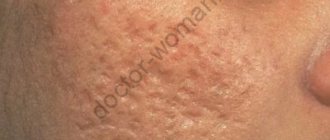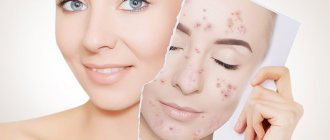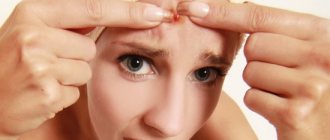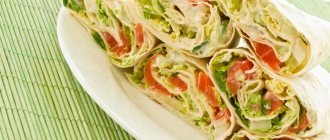In this article we will tell you:
- Causes of acne
- Symptoms of hyperandrogenism
- Other factors causing acne
- Foods that cause acne
- Foods that help get rid of acne
- The role of vitamins and antioxidants in the fight against acne
- Using antibiotics to treat acne
- Example of a diet for treating acne
There is no more common skin condition than acne.
Scarring that remains a silent reminder, psychological trauma and disorders such as low self-esteem, depression and anxiety - all this negatively affects the quality of life of both a teenage girl and an adult, self-sufficient woman.
A 10-year-old respondent once said: “You concentrate so much on your pimples because they are the first thing you see when you look in the mirror.”
However, this is not only a problem that teenagers face during puberty. According to statistics, 50.9% of women aged 20 to 29 years and 26.3% of women aged 40-49 suffer from acne. So what is its cause and how to deal with it?
Causes of acne
The main factors leading to acne are:
- Change in follicular keratinization
(this is the process of deposition of specific protein substances in the epidermis, the outermost layer of the skin, as well as fats in the stratum corneum, due to which it acquires strength and elasticity), which leads to the formation of comedones.
- Increased sebum production under the influence of androgens
- the main actors and culprits of acne. This is evidenced by the absence of acne in women who are insensitive to male sex hormones, as well as an increase in the level of dehydroepiandrosterone sulfate due to the appearance of acne in girls in the premenarchal period (that is, before the onset of the first menstruation).
With a lack of androgen receptors in the follicles, seborrhea may develop, but there are no comedones and inflammatory lesions, as studies have shown.
- Adverse effects of propionobacteria
.
Propionic bacteria are the most common inhabitants of human skin and generally help maintain its natural microbial balance.
On the one hand, they do not play a leading role in the mechanisms of acne - for most people they do not even cause any kind of problems of an aesthetic nature or with health in general.
On the other hand, some species produce large quantities of lipases - enzymes that break down sebum and thereby contribute to the formation of pro-inflammatory substances (in particular, short-chain fatty acids). Together, these factors, by activating various receptors, lead to the production of signaling molecules-cytokines by cells of the immune system, and also stimulate the release of peptidases that destroy proteins of the extracellular matrix.
Study
: Propionibacterium acnes and Acne Vulgaris: New Insights from the Integration of Population Genetic, Multi-Omic, Biochemical and Host-Microbe Studies
- Complex inflammatory mechanisms
, which include both innate and acquired immunity.
Experts' opinion
Based on the results of numerous clinical studies, La-Cri products are recommended by the St. Petersburg branch of the Union of Pediatricians of Russia.
The composition of all products in the Stop Acne series contains the unique ALPAFLOR ALP-SEBUM complex, with a proven effect:
- the number of spots (acne) decreases by 24%.
- Sebum production decreases by 56%, which leads to oily skin, shine on the face, and as a result, the formation of acne.
- pore size decreased by 18%.
- 91% of women noted improvement in their skin condition.
Sources:
- Habiff Thomas P., Clinical Dermatology. Acne-like and papulosquamous dermatoses, publishing house: MEDpress-inform, 2014
- M. Yu. Anisimova, Acne (Acne vulgaris) from the perspective of evidence-based medicine, Journal of Reproductive Health, 2010 cyberleninka.ru/article/v/akne-acne-vulgaris-s-pozitsii-dokazatelnoy-meditsiny
- M.V. Shishkova, L.M. Shnakhova, Some aspects of the modern approach to acne therapy, Almanac of Clinical Medicine, 2007 cyberleninka.ru/article/v/nekotorye-aspekty-sovremennogo-podhoda-k-terapii-akne
Photos acne
Photo album on the diseaseSymptoms of hyperandrogenism
- Acne
.
- Hirsutism
- Excessive growth of coarse, dark and long male-pattern hair (i.e. on the chin, in the sternum area and around the nipple areola, upper back and abdomen).
It is observed in 70% of women, thus being the most common symptom. It is closely associated with increased serum free testosterone levels.
Given that hair removal may interfere with the diagnosis of hirsutism, patients should be asked about the nature and frequency of hair removal methods, as well as locations of excessive hair growth. You can also ask them to self-assess the presence or absence of excess hair using the scale below:
- Seborrhea
- disruption of the sebaceous glands, accompanied by excessive production of their secretion with a high content of free fatty acids.
- Androgenetic alopecia
- thinning of hair and subsequent baldness of the parietal, frontal areas and thinning of the central parting of the head.
- Amenorrhea
- absence of menstruation for 6 months, subject to a previously normal cycle.
- Oligomenorrhea
- scanty, infrequent menstruation.
- Virilization
- a complex of symptoms manifested by the appearance of male facial features, physique and timbre of voice in women.
- Clitoromegaly
- pathological enlargement of the outer part of the clitoris.
- Infertility
.
- Polycystic ovary syndrome
.
- Increased muscle mass
.
- Reducing breast size
.
- Anovulation in two of three cycles
.
(However, up to three cycles per year can normally
be anovulatory).
Other factors causing acne
Cosmetics
The use of harsh skin care products and inappropriate cosmetics can aggravate acne by changing the skin barrier and microbiota balance (especially in the sebaceous gland area), thereby activating innate immune mechanisms and causing inflammation.
Acne cosmetic, first described in 1972, is characterized by scattered comedones on the face with very few inflammatory lesions such as pustules and papules. Triggers include ingredients in cosmetics such as essential oils, harsh skin cleansers, and soaps with a pH of 8.0.
Briolin, used for hair care, giving it shine, and also for fixing it, as noted, can cause comedones in the forehead and temples.
Lifestyle
There is evidence that psychosocial and lifestyle factors, including stress, emotions, and lack of sleep, influence the development of inflammatory skin diseases.
We recommend
“Psychology of stress: types, stages, ways of dealing with it” Read more
Short-wavelength visible light emitted by smartphone screens has been shown to increase the proliferation of Staphylococcus aureus, thereby disrupting the balance of skin microbiota, according to recent studies.
Cigarette smoke, a complex aerosol containing more than a thousand chemicals, including nicotine, carbon monoxide, tar, formaldehyde, hydrocyanic acid, ammonia, mercury, lead and cadmium, increases trans-epidermal water loss, connective tissue degeneration, and also activates metalloproteinases that destroy collagen and elastic fibers.
Study
: The influence of exposome on acne
Demodex
Demodicosis is an ectoparasitosis that manifests itself as skin diseases of the scalp and is caused by mites.
Mites can migrate from one follicle to another at a speed of 8-16 mm within 7 hours. It is believed that females lay their eggs in deeper areas of the hairline, where the young can continue to develop until they reach mature size.
The tick's body is covered with a hard exoskeleton, and the presence of chitin in it can act as a foreign body and contribute to the formation of granulomas.
Most likely, when Demodex disrupts the integrity of the epithelial barrier, its antigens are recognized by the host's immune system and cause a type 4 (delayed) hypersensitivity reaction.
Their metabolic products, directly or together with associated bacteria, can activate elements of the innate immune system.
It is believed that this parasite also carries Bacillus oleronius, which acts as a co-pathogen in the development of severe forms of blepharitis (eye disease). Their proteins have been shown to cause neutrophil activation, which leads to inflammation, which is so closely associated with the development of acne.
An increased number of mites is also associated with a high tendency of leukocytes to undergo apoptosis, leading to local immunosuppression, which only facilitates the survival and reproduction of demodex.
A high glycemic index of foods and insulin resistance cause hyperandrogenism and provoke the development of acne. The study, which involved volunteers aged 10 to 24 years, found that those with a lower body mass index (BMI) were significantly less likely to develop acne than those with a higher BMI.
It was also reported that the adverse effects caused by ticks in obese people were more severe compared to healthy control groups.
Some authors have suggested that impaired blood glucose regulation, excess body weight, and metabolic syndrome increase susceptibility to Demodex infection.
Thus, it was noted that the serum concentration and expression in skin tissues of insulin-like growth factor-2 (IGF-2) increases not only in generalized demodex in dogs, but also in patients with acne.
Study
: Demodex spp. as a possible aetiopathogenic factor of acne and relation with acne severity and type
Foods that cause acne
- Milk
Most dermatology textbooks still define acne as an androgen-dependent skin disorder - and indeed, there is no doubt that excess of these hormones contributes to the appearance of pimples and seborrhea. The absence of acne in conditions of loss of its androgen receptor function and, as a consequence, the insensitivity of cells to these hormones, only once again proves the importance of their role in the pathogenesis of acne development.
However, there is still an unresolved controversy: it is well established that serum androgen levels increase during puberty and remain high for several decades, while acne is physiologically
disappear spontaneously after puberty.
Scientists have suggested
: Not androgens, but serum levels of insulin-like growth factor-1 (increasing during puberty under the influence of somatotropin - growth hormone) play a major role in the mechanisms of acne pathogenesis.
Insulin-like growth factor-1 (IGF-1) or somatomedin C is a protein synthesized by liver cells and has a similar structure and function to insulin molecules (and, as we already know, it has an anabolic
action).
We recommend
“Nutrition for dummies: where to start?” More details
There is a hereditary disease called Laron syndrome - such patients have short stature caused by defects in the gene (GHR) responsible for the expression of the growth hormone receptor (known as growth hormone). This mutation also leads to congenital IGF-1 deficiency. It is noteworthy that patients who are not treated with recombinant IGF-1 never develop acne, while its administration causes hyperandrogenism and, as a result, acne - this already leads to speculation that IGF-1 enhances transcriptional activity androgen receptors.
Moreover, by binding to its receptor, IGF-1, by triggering a cascade of signaling pathways, stimulates the growth and division of cells - in particular, epithelial cells of the sebaceous glands.
In addition, IGF-1 is a powerful inducer of testosterone synthesis in the gonads (sex glands) and dehydroepiandrostenedione (DHEA) in the adrenal cortex. It also suppresses the formation of sex hormone binding globulin (SHBG) in the liver, which leads to an increase in the fractions of free, and therefore active, androgens in the blood.
It also promotes the intradermal conversion of testosterone to dihydrotestosterone (the most physiologically potent androgen) by increasing the activity of the enzyme 5-alpha reductase. In this case, androgens, in turn, induce IGF-1 in the hair follicle.
Milk is a special product of evolution, the main task of which is to stimulate the processes of anabolism, that is, synthesis, and the active growth of newborn mammals. Specific amino acids in its composition increase the secretion of insulin and IGF-1.
Consumption of 710 ml of ultra-heat-processed milk in prepubertal children unaccustomed to this type of feeding for four weeks significantly increased serum IGF-1 and growth hormone levels - this was not due to its IGF-1 content , but due to its production by the liver under the influence of specific amino acids.
Notably, milk's main whey protein, alpha-lactalbumin, has the highest tryptophan content of any other dietary protein source. The presence of this amino acid is critical in the synthesis of IGF-1 by hepatocytes.
In addition, the branched chain amino acids (BCAAs) of milk - leucine, isoleucine, valine - cause the pancreatic cells to secrete insulin - this explains the high insulin index of both whole and skim milk.
We recommend
“Common types of diets in nutritionology and their descriptions” Read more
The prevalence of acne, scientists have observed, increased significantly among Okinawans and Chinese after switching from their traditional diet to a Western diet.
Research highlights that 75-90% of all commercial milk in the US comes from pregnant cows - and it contains dihydrotestosterone precursors (5-alpha-androstenedione) as well as placenta-derived progesterone. Also during this period, the animal’s adrenal glands produce significant amounts of DHEA, which can be converted by the enzyme 3-beta-hydroxysteroid dehydrogenase into androstenedione.
Let's get to the numbers
: Milk from pregnant cows contains 3.4 times more androstenedione (compared to non-pregnant cows), 1.2 times more DHEA and 1.3 times more testosterone. Impressive, isn't it?
Many studies have shown that skim milk is more comedogenic than whole milk. Its production is thought to alter the biological activity of glucocorticoids and transforming growth factor beta, as well as hormones similar to thyrotropin and opiates, all of which lead to changes in their interactions with binding proteins. In addition, to maintain proper consistency, manufacturers add whey proteins (such as alpha-lactoalbumin), whose role in the pathogenesis of acne is also far from the last.
Supplements used by athletes (such as whey proteins) contain leucine and may therefore cause and/or worsen acne: this amino acid stimulates insulin-like growth factor-1 (IGF-1). Scientists, given the anabolic role of insulin and similar biologically active molecules, call for considering, similar to the abuse of androgens in bodybuilding, excessive consumption of milk protein as a form of doping.
Study
: Linking diet to acne metabolomics, inflammation, and comedogenesis: an update
- Simple sugars
High intake of refined sugars plays a key role in the pathogenesis of acne. The effect of high glycemic load diets on acne induction and exacerbation has been supported by many placebo-controlled studies.
A low glycemic load diet increased the secretion of IGF-1 binding proteins, while a high carbohydrate diet decreased the secretion of sex hormone binding globulin—thus increasing serum levels of FREE androgens.
Research shows
: Restricting fast sugars for 10 weeks led to a decrease in the size of the sebaceous glands, as well as a decrease in sebum production and an increase in the ratio of saturated to monounsaturated fatty acids.
High concentrations of glucose in the blood activate the expression of microRNA-21 in macrophages, a central regulator of cell division and inflammatory mechanisms.
- Chocolate
Chocolate has always been considered as a factor that can cause exacerbation of acne - for example, dermatologists note the appearance of new acne in their patients a few days after eating it.
In a study of Greek students aged 13-18 years, 66% of them noted chocolate as a factor aggravating the course of the disease.
However, other data are no less contradictory. In the experiment, which involved 30 teenagers and 35 men, all subjects were divided into two groups - the first took chocolate bars that contained ten times more cocoa than standard candies; while the second consumed bars that did not contain it at all. There were no differences in sebum composition between the two groups, meaning no association was found between chocolate consumption and worsening skin conditions. The results are still not conclusive: they did not take into account additional ingredients eaten by the subjects.
The Journal of the American Academy of Dermatology published an article in 2011 that reported that respondents' acne worsened after eating chocolate once, but did not provide information about the type of chocolate or the percentage of cocoa it contained.
Dark chocolate is known to contain more antioxidants than milk chocolate and, as a result, has much less comedogenic effects. However, the question of its overall role still remains open.
Study
: Significance of diet in treated and untreated acne vulgaris
Another study added even more controversy: It found that consuming small amounts of 99% dark chocolate for four weeks resulted in a statistically significant increase in acne severity. This was explained by the high concentration of cocoa butter, which contains a large amount of oleic acid, which can affect the keratinization of the skin and thereby contribute to the development of comedones.
- Trans fats
Palmitate activates the proliferation of keratinocytes (epidermal cells) and promotes the formation of comedones.
Notably, it is the major fatty acid, accounting for 32% of all triglycerides in milk.
Trans fats, the main components of fast food, are structurally similar to palmitic acid. They have replaced natural solid fats and liquid oils in snacks, fried foods and baked goods.
- Iodine
Iodine is a mineral necessary for the normal and proper functioning of not only the thyroid gland, but the entire body as a whole.
Acne that occurs after eating food rich in iodine appears suddenly and is characterized by many papules. Hence, it has been suggested that the relationship between the development of acne and milk consumption may also lie in the content of this halogen in dairy products and, accordingly, depend on the time of year, location, additives in animal nutrition and the use of iodophor as disinfectant solutions.
Study
: Significance of diet in treated and untreated acne vulgaris
Foods that help get rid of acne
Recommendations:
- Replace milk with fermented milk products.
Yogurt consumption did not correlate with acne in this study. This is explained by the fact that probiotic bacteria (in particular, lactobacilli) added to milk during fermentation utilize IGF-1 and thereby reduce its concentration by 4 times compared to skim milk.
It has also recently been noted that lactoferrin-enriched fermented milk products are effective in reducing triglyceride levels of lipids on the surface of the skin, which reduces sebum production.
- Avoid simple sugars.
Treatment of acne cannot be considered separately from the treatment of insulin resistance. Normalizing carbohydrate metabolism is an undeniable guarantee of success and clean, beautiful skin.
- Add fiber to your diet.
In one study, patients suffering from acne ate 30 grams of cereal daily for breakfast, containing 13 grams of fiber per serving. At the same time, they noted a significant improvement in their skin condition. It was also present after introducing a diet with a low glycemic load to other volunteers - this was due to the large amount of dietary fiber, as the researchers suggested.
- Eat more fermented foods.
Probiotics can also provide significant benefits: Lactobacillus rhamnosus supplementation was associated with better clinical outcomes in 20 patients compared with the placebo group; Lactobacillus acidophilus and Bifidobacterium bifidum, in addition to standard antibiotics, also improved skin conditions. Oral probiotics can reduce systemic oxidative stress, regulate cytokine production, and reduce markers of inflammation.
- Add omega-3 fatty acids to your diet.
Eicosapentaenoic acid (EPA), the main omega-3 fatty acid in fish oil, inhibits the development of acne.
Studies have shown significant improvements in acne when patients took 3 grams of fish oil containing 930 mg EPA for 12 weeks. Adding borage oil with gamma-linolenic acid to the diet also reduced skin lesions, both inflammatory and non-inflammatory.
Omega-3 fatty acids have the ability to reduce IGF-1 levels, which has a beneficial effect in the treatment of acne.
A North Carolina study of 1,000 teenagers found that those who ate more fish and seafood had less acne.
Eicosapentoenoic acid and gamma-linolenic acid are reported to inhibit the conversion of arachidonic acid to the inflammatory leukotriene B4, which stimulates sebum production, to the same extent as the drug zileuton, which has proven effective in treating acne.
Research
: The influence of exposome on acne, Linking diet to acne metabolomics, inflammation, and comedogenesis: an update, Significance of diet in treated and untreated acne vulgaris, Acne vulgaris, mental health and omega-3 fatty acids: a report of cases
Omega-6 and omega-3 fatty acids
Omega-6 fatty acids are considered pro-inflammatory mediators and can increase the risk of acne. Omega-3 fatty acids are characterized by an anti-inflammatory effect; they reduce the likelihood of acne by suppressing inflammation and restoring hormonal balance by reducing IGF-1 levels.
There is evidence that enriching the diet with seafood and fish reduces the severity of acne. It is believed that the optimal amount of eating fish is 3 times a week. It is best to get omega-3 from salmon, mackerel, herring, sardines, and tuna. 42
The role of vitamins and antioxidants in the fight against acne
Antioxidants
Reactive oxygen species produced by neutrophils are involved in the inflammatory progression of acne. It has been suggested that oxidative stress may be involved in the origin of acne and that medications with antioxidant effects may be valuable aids in the treatment of acne.
A 2008 study of 100 healthy volunteers and 100 patients suffering from acne found that the latter had significantly lower concentrations of vitamins A and E, fat-soluble antioxidants. They also had low concentrations of selenium, a mineral necessary for the functioning of the enzyme glutathione peroxidase.
- Green tea catechins,
as shown by the study of simulated situations in hamsters, they inhibit the production of sebum.
- Nobiletin
, a flavonoid found in the juice of the Taiwanese mandarin orange (Citrus depressa), inhibits lipogenesis (fat synthesis) and cell proliferation of the sebaceous glands.
- Resveratrol
- a polyphenolic flavonoid found in red grape skins, peanuts and mulberries - suppresses Mtorc1 signaling, and also inhibits the growth of P. acnes and eliminates their biofilm formation.
Topical treatment of acne on the faces of 20 patients with a resveratrol-containing gel significantly reduced the number of comedones, papules and pustules compared to the control group.
In addition, it has antioxidant properties, improves cell sensitivity to insulin and increases the number of mitochondria.
- Selenium
- is part of glutathione peroxidase, an enzyme that, together with vitamin E, is part of the antioxidant system that protects the human body from the tirelessly generated free radicals.
Zinc
It is an essential mineral that plays a key role in physical growth and development, immune system function, reproductive health, and neurobehavioral development.
About 33% of people worldwide have a zinc-deficient diet. Its mild deficiency is associated with weakened immunity, impaired sense of smell and taste, deterioration of night vision, and decreased spermatogenesis, while severe deficiency is associated with pustular dermatitis, diarrhea, dementia and severe immune depression.
Decreased serum zinc levels may also lead to increased androgen production, which will directly affect sebaceous gland activity.
This mineral also suppresses P. acne, activates natural killer cells and stimulates the phagocytic ability of granulocytes. Its anti-inflammatory activity in acne also includes a decrease in the production of tumor necrosis factor and interleukin-6.
Zinc is necessary for the synthesis and secretion of retinol binding protein (RBP), a specific transporter that displays the amount of vitamin A available to tissues.
We recommend
“What are the benefits of zinc for the human body” Read more
The study involved 173 patients and showed that those with more severe acne had lower levels of RBP than those with less severe acne. The situation was similar with their zinc levels - this became the rationale for its use in the treatment of acne.
Plasma zinc concentrations must be interpreted with caution and should be sampled on an empty stomach: levels of this mineral have been reported to decrease by 20% after meals. Low values can, in addition to deficiency conditions, be observed in tumors and chronic liver diseases - therefore, C-reactive protein (a marker of the acute phase of inflammation) can help with the interpretation of the analysis.
It is better to use its chelated forms (picolinate, glycinate, acetate) as oral supplements.
Zinc is found in wheat bran, eggs, pine nuts, asparagus, herring, and lentils.
It must be remembered that this mineral reduces the absorption of copper (they are antagonists), which can contribute to the development of anemia.
Study
: Correlation between the Severity and Type of Acne Lesions with Serum Zinc Levels in Patients with Acne Vulgaris
Vitamin A
Vitamin A is a group of compounds that can be found in animal and plant foods.
Retinol and its derivatives are found mainly in milk, dairy products, eggs, liver, and fish. Plant foods contain mainly provitamin A (carotenoids).
Beta-carotene is converted into retinol under the action of the enzyme beta-carotene monooxygenase-1, the formation of which is responsible for the BCMO1 gene, which is why it is so important when switching to vegetarianism to look at the genetic panel of vitamins for the presence of polymorphisms.
Vitamin A is a fat-soluble vitamin that can be stored in the liver.
Studies have noted that high-dose oral retinol supplements are indicated for the treatment of acne, with cheilitis and xerosis being the only side effects observed.
Taking 20 mg/day of isotretinoin (13-cis-retinoic acid) for three months was also effective and had a lower incidence of side effects than higher doses.
Study
: Low-dose Vitamin “A” Tablets–treatment of Acne Vulgaris
Vitamin C
Oxidative stress during lipid peroxidation can initiate the release of inflammatory agents that contribute to the development of various pathologies.
Ascorbate normalizes the lipid profile of the epidermis (in particular, glucosphingolipids and ceramides).
Vitamin C is found in rose hips, currants, strawberries, kiwi, and sauerkraut. Does not accumulate in the body.
Study
: Oxidant/antioxidant status in obese adolescent females with acne vulgaris
Vitamin E
This vitamin exhibits high activity in neutralizing free radicals, including singlet oxygen, superoxide and hydroxyl radicals.
Studies have shown that daily oral alpha-tocopherol leads to a significant increase in vitamin E levels in human skin—especially in areas with a high density of sebaceous glands.
Since oral vitamin E only affects sebum after several weeks, its topical use in the treatment of acne has attracted equally strong interest from dermatologists. Doctors noted that using it in tandem with benzoyl peroxide (used instead of antibiotics) made it possible to achieve much stronger effects.
Study
: Addressing Free Radical Oxidation in Acne Vulgaris
Green tea
Green tea contains polyphenols, the most common being EGCG (epigallocatechin gallate). It is mainly absorbed in the small intestine and metabolized by the microflora of the colon.
Has high bioavailability
: EGCG is present in plasma immediately after drinking green tea. Its oral bioavailability is increased by fasting, fish oil, albumin, piperine and vitamin C, while oxidation by air, metal ions, catechol-O-methyltransferase polymorphisms and gastrointestinal inactivation significantly reduce it.
Research on the penetration of tea polyphenols into human skin is limited - at the moment, some scientists note that higher levels of EGCG are found in the stratum corneum, then in the epidermis and dermis, which suggests that this compound is unpopular.
There is evidence that 98% of P.acnes, P.granulosum, S.aureus. S. epidermidis, implicated in the pathogenesis of acne, were inhibited by a concentration of 400 μg of gallic acid contained in green tea.
EGCG also increased apoptosis of the SEB-1 sebocyte cell line and had lipogenic and anti-inflammatory effects.
Study
: Green Tea and Other Tea Polyphenols: Effects on Sebum Production and Acne Vulgaris
Myoinositol
Myoinositol is increasingly used by nutritionists to correct impaired carbohydrate metabolism. Its functions, however, are not limited to this: it is involved in the mechanisms of cell growth, the development and functioning of the peripheral nervous system, osteogenesis, lowering LDL (low-density lipoprotein) levels, as well as increasing HDL (high-density lipoprotein).
We recommend
“Complex carbohydrates for weight loss, muscle gain and diabetics” Read more
It plays an important role in maintaining reproductive function, improving the quality of oocytes, restoring ovulation and fertility, reducing the manifestations of hyperandrogenism and insulin resistance - thanks to these properties, it is actively used in the treatment of polycystic ovary syndrome.
It is believed that myoinositol leads to an increase in the transport of glucose into the cell through a specific transporter GLUT4, and thereby enhances the action of endogenous insulin.
Study
: Myoinositol in the Prevention of Gestational Diabetes Mellitus: Is It Sensible?
Chromium
Chromium is a mineral responsible for glucose metabolism. Its absorption is enhanced by vitamin C.
Found in broccoli (11 mcg/0.5 cup) and turkey (10.4 mcg/3 oz).
Basic nutritional rules for treating acne
1st rule. First of all, it is necessary to strictly limit the consumption of sweets. But in most cases, at the beginning of treatment, you should completely abandon various types of sweets, chocolate and other confectionery products. Since such treats clog and clog the esophagus, which can result in digestive problems.
The 2nd rule says - completely remove from your daily diet all drinks with dyes and unnatural flavoring additives, namely cola, Pepsi, Sprite, Fanta, etc. Their consumption also has a detrimental effect on the digestion process, which, of course, negatively affects the condition of the skin. By the way, this rule also applies to coffee.
The 3rd rule of the diet for facial acne prohibits including fried foods in your daily diet. This helps to increase the oiliness of the skin, and the more oily it is, the faster and better the development of the bacterium Propionibacterium acnes - the main causative agent of acne.
The 4th rule prohibits the consumption of alcoholic beverages. Also, if possible, it is necessary to give up tobacco products or reduce their consumption for the first time.
The 5th rule indicates the need to alternate foods daily. For example, today’s menu includes rice, tomorrow’s menu includes buckwheat, and the day after tomorrow’s menu includes pasta. Using such a nutritional scheme, our body will receive all the vital elements and will show the gastrointestinal tract that there is no need to relax.
In accordance with these rules for a diet for acne on the skin, you can create the following menu for one day:
- breakfast - a cup of green or black tea, several sandwiches with cheese and fruit (for example, banana and green apple);
- lunch - vegetable soup (helps normalize the digestion process), and for the second - rice, buckwheat porridge or mashed potatoes;
- afternoon snack – freshly squeezed juice and several fruits of any kind;
- dinner - cottage cheese with a small percentage of fat, tea with sandwiches, and before bed - a glass of kefir.
Using antibiotics to treat acne
Interesting fact
: Dermatologists make up no more than 1% of all doctors, but they are responsible for 4.9% of all antibiotic prescriptions. They use them primarily to treat acne - and this practice plays an important role in the mechanisms of development of bacterial resistance to antibiotics.
Although acne is not caused by an excess of P. acne, germicidal drugs have long held a dominant position in the treatment of acne and have been used as monotherapy.
The most frequently used:
- Tetracyclines (tetracycline, doxycycline, minocycline).
- Macrolides (erythromycin and, more rarely, clindamycin).
- Sometimes sulfonamides.
It is believed that the therapeutic effect of systemic antibiotics is primarily due to their anti-inflammatory properties - this is especially true for tetracyclines.
However, their abuse has led to serious consequences: if in 1978 only 20% of P. acne were resistant to antibiotics, today approximately ⅔ of the population is resistant to them.
Both systemic and local antibiotics are capable of changing bacterial resistance. Topical erythromycin has been shown to cause overgrowth of resistant bacteria both locally and at more distant sites.
We recommend
“How to take probiotics correctly to avoid side effects” Read more
Moreover, their use is accompanied by damage to the normal flora of the skin and increases the risk of its colonization by pathological microorganisms. For example, long-term courses of tetracycline treatment cause an overgrowth of gram-negative bacteria in the nostrils, which is associated with folliculitis.
Active reproduction of Streptococcus peogenes and Staphylococcus aureus also occurs in the pharynx and oral cavity, which leads to chronic pharyngitis.
In addition, colonization with antibiotic-resistant bacteria occurs not only in patients undergoing treatment, but also in their family members.
Use of Clindovit® gel in acne therapy
Correction of nutrition is an important step in the treatment of acne, but to obtain a pronounced effect it is necessary to use topical and systemic medications (depending on the severity of acne). One of the topical medications used for mild to moderate acne is Clindovit®6. This is a 1% clindamycin gel that has an antibacterial effect. After application to the skin, the antibiotic accumulates in comedones, helping to reduce propionibacteria colonies6. The base also includes auxiliary components: allantoin and emollient6.
*elements of acne
An example of a diet for the treatment of acne
As previously stated, the main task is to reduce the amount of simple, easily digestible sugars that provoke increased secretion of insulin by pancreatic cells, and also to eliminate all food waste in the form of fast food, soda and any other sources of trans fats and sugar.
THE FIRST DAY
| Breakfast | Ghee omelette with aged cheese | Half an avocado, sesame seeds and cherry tomatoes with fragrant basil | A serving of fresh berries: raspberries/currants/blackberries - start your morning with antioxidants |
| Dinner | Roast turkey | Sweet potato or broccoli puree | A serving of green salad - where without folic acid? |
| Dinner | Grilled vegetables and aromatic spices | Quinoa or amaranth for garnish |
SECOND DAY
| Breakfast | Coconut yoghurt with almond flakes | Quail eggs | Several flax loaves |
| Dinner | Lentil cream soup | Sauerkraut—Add Some Probiotics to Your Diet | Salad of avocado, green leaves and your favorite variety of cabbage with tart tahini sauce |
| Dinner | Lean sea fish | Amaranth as a garnish |
DAY THREE
| Breakfast | Avocado toast with poached egg | Several slices of salted salmon | A cup of fragrant strawberries |
| Dinner | Warm salad of bulgur and baked vegetables. | A glass of broth is a source of collagen for beautiful skin | Baked rabbit |
| Dinner | Do intermittent fasting - start autophagy processes. |










